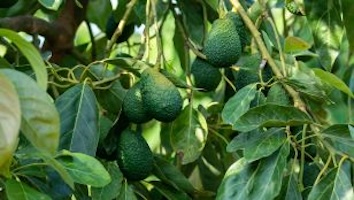Lesson 4 - Tropical and subtropical fruits

Many parts of Australia have subtropical and tropical climates, including some of our largest cities. Tropical climates are found in the far north of the country, including parts of the Northern Territory, Queensland and Western Australia and are characterized by year-round warm and humid conditions with wet and dry seasons. Subtropical climates are south of the tropics, extending from Sydney to Mackay on the east coast, and have milder, relatively dry winters and hot, humid summers. Tropical fruits require consistently warm conditions across the year and are very sensitive to cold, most needing above 10°C minimums to grow successfully. Examples include mangoes, bananas, lychees, dragon fruit, papaya, pineapples and guava. Subtropical fruiting species also need warmth for most of the year but can tolerate cooler temperatures, some even as low as 0°C. Even though the climates are different from a growing perspective it’s easiest to group tropical and subtropical fruits together. Particularly as many gardeners grow tropical and subtropical fruits in temperate climates, particularly the fruiting species and/or cultivars that can tolerate cooler conditions. Some gardeners also modify the microclimate to suit these plants or even build protective structures such as polytunnels to mimic more tropical conditions in which to grow these plants.
Let’s look at one of the most grown subtropical fruits – the avocado (Persea americana). Cultivated in in Mexico for several thousand years, the avocado spread to other parts of the globe during the 17th century, particularly from the English-speaking Caribbean islands. Reflective of this origin, there are three distinct ‘races’ of avocados, based on their fruiting traits and environmental tolerances, Guatemalan, Mexican and West Indian. It’s from these races that all modern cultivars have developed.
It's possible to grow avocadoes in most parts of Australia, provided there is good frost protection when trees are small. Avocados are evergreen trees that are best in open, sunny and sheltered sites with well-drained soils and plenty of space. Left unpruned standard avocado cultivars can reach 10-12 metres in height at maturity, and while there are some dwarf cultivars, these still grow to 4 m. Most growers prune avocados to manage their height. This starts with pinching the leading shoot when the tree is small, to encourage a low branching habit, followed by annual pruning to maintain an open shape and a maximum height of 2-3 m. Avocados are not hugely drought tolerant, so mulching and irrigation over summer may be needed, especially if you are gardening in warmer climates.
During spring avocado flowers develop in dense clusters, via a branching and spreading inflorescence known as a compound panicle. They also have a rather unique flowering behaviour, alternating between being actively female (receptive to pollen) to actively male (producing pollen) during the same day, or on subsequent days. Due to this behaviour avocados need the right pollination ‘partner’ to fruit successfully. This is based on the cultivars with the correct flowering sequence – either a Type A or Type B – and the climate where the trees are growing. There is an excellent Diggers webpage providing more information on this and the selection of avocado cultivars. It takes between 3-5 years for an avocado to start fruiting and while there are many thousands of flowers on a single tree, only a very small percentage of these are fertilised and develop into fruit. Individual fruits take up to 12 months to ripen, which is why there are often flowers and fruits on the tree at the same time. The fruit load on some trees can be significant and may need to be thinned to avoid damage to branches. A useful feature of avocados for the home gardener is that the fruit can effectively be ‘stored’ on the tree until its ready for use. When a fruit has matured it will have reached its full size, however it won’t soften and ripen within a week or so of being harvested.
Avocados in home gardens not subject to serious pests, apart from fruit fly in affected areas. They are however very susceptible to phytophthora root rot which leads to decline in tree health and productivity. It can be managed by improving soil drainage, using disease-resistant rootstocks or phosphonate treatments. The latter are safe to use and are applied as either a foliage spray or trunk injection, helping to suppress the disease pathogen inside the tree.
Further learning
Further learning
- Avocados - Gardening Australia
- Tropical Food Gardens: A guide to growing fruit, herbs and vegetables organically in Australia by Leonie Norrington (Bloomings Books, 2011)